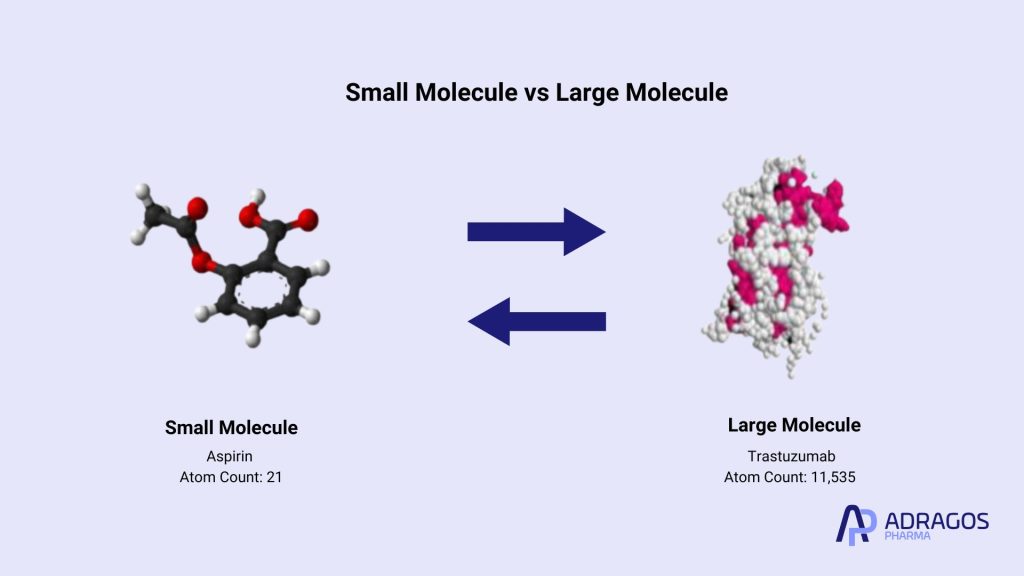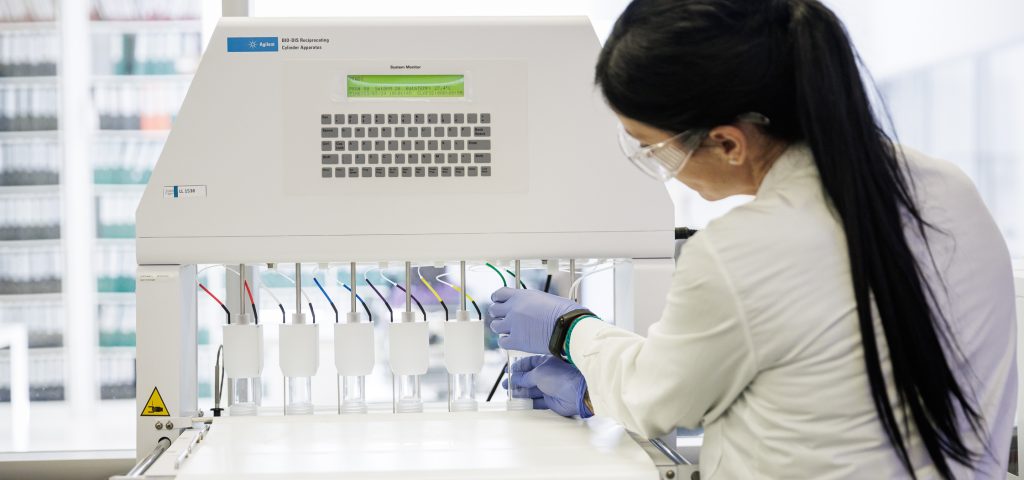The pharmaceutical industry relies on two primary types of drugs: small molecules and large molecules. Both play essential roles in modern medicine, yet they differ significantly in structure, function, and production methods. Understanding these differences between small and large molecules is crucial for professionals involved in drug development and manufacturing processes.
This article explores the characteristics of large molecules, how they compare to small molecules, and their impact on pharmaceutical drug development.
Defining Large Molecules: Characteristics and Importance
What Are Large Molecules?
Large molecules, or biologics, have a large molecular weight and are manufactured or extracted from living organisms. They are made of proteins that are complex in structure and much less stable compared to small molecule drugs. Unlike small molecule drugs, which mostly are chemically synthesized, large molecules are derived from living cells. Their complexity enables them to target specific biological processes with high precision, making them highly effective in treating various diseases, including cancer and autoimmune disorders. Effective biologics characterization relies heavily on robust process development to ensure successful outcomes in a phase-appropriate manner.
Key Characteristics of Large Molecules
- High molecular weight: Typically larger than small molecule drugs, requiring specialized analytical techniques such as mass spectrometry (LC-MS) and size exclusion chromatography.
- Biological origin: Produced using living organisms, often requiring cell line development and upstream/downstream processing.
- Complex structures: Involves intricate chemical bonds and post-translational modifications that affect function and stability.
- Specific mode of action: Often designed to interact with particular cellular targets, such as monoclonal antibodies that bind to antigens.
- Limited oral bioavailability: Due to their size and instability in the digestive system, most large molecule drugs are administered via injection or intravenous infusion.
Small Molecules: A Comparison
What Are Small Molecules?
Small molecules are low molecular weight compounds that can be synthesized through organic chemistry. They form the foundation of many traditional pharmaceutical drugs, including antibiotics, pain relievers, and cardiovascular medications.
How Do Small Molecules Differ from Large Molecules?
Size and molecular weight: Small molecules typically have a low molecular weight, allowing them to diffuse easily across cell membranes.
Chemical synthesis: Unlike large molecules, which require living cells for production, small molecules are usually created through well-established synthetic drug processes.
Drug administration: Many small molecule drugs can be taken orally, whereas large molecules require specialized drug delivery systems.
Regulatory considerations: Small molecules generally have simpler FDA approval pathways compared to large molecules, which undergo extensive testing for immunogenicity, binding assays, and clinical trial phases.
While small molecule drugs remain widely used, large molecules have become increasingly important due to their ability to address diseases that previously had limited treatment options. Maintaining the integrity of large molecules during the entire analytical process is crucial to ensure accurate and reliable results.
The Manufacturing Process for Large Molecules
Production Through Living Cells
Developing large molecule drugs is significantly more complex than producing small molecule drugs. Since large molecules are typically derived from living cells, the manufacturing process involves multiple critical steps, including:
- Cell line development: Selecting and optimizing cell lines capable of producing the required protein or monoclonal antibody.
- Upstream processing: Cultivating the cells in bioreactors under controlled conditions to maximize protein production.
- Downstream processing: Using techniques such as ion exchange chromatography and reversed-phase chromatography to purify the large molecule drug.
- Quality control: Ensuring data integrity and consistency in molecular weight, chemical structure, and biological activity.
The pharmaceutical drug development of large molecules requires sophisticated method development to maintain stability and efficacy.
The Role of Large Molecules in Drug Development
Monoclonal Antibodies and Therapeutic Proteins
One of the most significant advancements in large molecule therapeutics has been the development of monoclonal antibodies. These laboratory-engineered proteins are designed to recognize and bind to specific antigens, making them highly effective for targeted therapies.
Examples include:
- Herceptin (trastuzumab): Used for breast cancer treatment.
- Humira (adalimumab): A monoclonal antibody that blocks inflammation in autoimmune diseases.
Bevacizumab: Used in cancer therapy to inhibit blood vessel growth in tumors.
Additionally, therapeutic proteins such as insulin and growth factors have transformed the treatment of metabolic and genetic disorders.

Gene Therapy and Nucleic Acids
Recent advancements in genetic information have led to the development of nucleic acid-based therapies. These large molecules, including DNA and RNA, play a crucial role in exon skipping strategies for genetic diseases and cell-mediated therapies.
Benefits and Limitations of Small and Large Molecule Drugs
Efficacy and Safety Considerations
Both small and large molecule drugs have unique benefits and limitations that must be carefully considered during the drug development process.
Small molecule drugs are often favored for their ease of synthesis, optimization, and administration. Their low molecular weight allows them to diffuse easily across cell membranes, making them effective for treating a wide range of diseases. Additionally, many small molecule drugs can be taken orally, which is convenient for patients. However, small molecules can also have limitations, such as off-target effects, toxicity, and limited bioavailability.
Large molecule drugs, on the other hand, are known for their ability to target complex biological pathways and modulate immune responses. These drugs, often derived from living cells, can be designed to interact with specific cell surface receptors, making them highly effective for treating diseases such as cancer and autoimmune disorders. However, large molecules also present challenges, including difficulty in synthesis and optimization, limited bioavailability, and potential immunogenicity. Due to their size and complexity, large molecule drugs are typically administered via injection or intravenous infusion.
Efficacy and safety considerations are critical when developing both small and large molecule drugs. This involves carefully evaluating the potential benefits and risks of each drug, as well as their interactions with other medications and biological systems. By understanding these factors, researchers and clinicians can develop effective and safe treatments for a wide range of diseases.
In conclusion, the development of small and large molecule drugs requires a deep understanding of their benefits and limitations, as well as their potential interactions with biological systems. By carefully considering these factors, researchers and clinicians can develop effective and safe treatments for a wide range of diseases.
Regulatory Challenges and FDA Approval
Complexity of Large Molecule Approval
Because large molecules are derived from living organisms, their FDA approval process is more rigorous than that of small molecules.
Regulatory agencies require extensive data on:
- Binding assays and ligand binding assays to confirm specificity.
- Post-translational modifications that could affect efficacy.
- Clinical trials to assess drug administration, immunogenicity testing, and controlled release mechanisms.
Companies must also ensure consistency in drug substance production, as slight variations in the manufacturing process can impact safety and effectiveness.
The Future of Large Molecule Drugs
Innovations in Drug Delivery
One of the biggest challenges in large molecule drug development is improving drug delivery. Researchers are exploring new approaches, such as:
- Nanoparticles and fusion proteins for targeted delivery.
- Continuous manufacturing to improve efficiency and scalability.
- Alternative administration routes to move beyond injections and infusions.
Expanding Treatment Possibilities
The continued research in large molecule therapeutics is expected to lead to groundbreaking treatments for rare diseases, cancer, and neurological conditions. The rise of biosimilars—highly similar versions of existing large molecule drugs—also presents opportunities for making these therapies more affordable and accessible.
The distinction between small molecules and large molecules is fundamental to modern pharmaceutical drug development. While small molecule drugs continue to be essential for many conditions, large molecules have introduced new possibilities in biologics, monoclonal antibodies, and genetic medicine.
Despite the challenges in manufacturing, regulatory considerations, and drug delivery, large molecules remain a driving force in the future of medicine. As research advances, these drugs will continue to shape the industry, providing innovative solutions for some of the most challenging diseases.
Frequently Asked Questions (FAQs) about Large Molecules
What are examples of large molecules?
Examples include monoclonal antibodies, therapeutic proteins, nucleic acids (DNA, RNA), and enzymes. These drugs are widely used in treating cancer, autoimmune diseases, and genetic disorders.
What are very large molecules called?
Extremely large molecules are often referred to as macromolecules or giant covalent structures, depending on their composition.
What are considered large molecules?
A large molecule is any pharmaceutical compound with a high molecular weight, typically derived from living cells, and used in biologics. Examples include monoclonal antibodies, nucleic acids, and therapeutic proteins.
What is an example of a large molecule drug?
Notable large molecule drugs include Humira (adalimumab) for autoimmune diseases, Herceptin (trastuzumab) for breast cancer, and insulin for diabetes.
